Policy Analysis: Healthcare Organisation Transparency, Accountability
VerifiedAdded on 2021/10/06
|13
|3472
|84
Report
AI Summary
This report provides a policy analysis of healthcare organizations, emphasizing transparency, accountability, and the implementation of SWOT analysis. The discussion covers the strengths and weaknesses of healthcare sectors, including the importance of medical equipment, technology, and employee motivation. The report highlights issues such as workplace culture, team management, communication challenges, and the impact of adopted policies. It also examines public policy, the role of the University of Pittsburgh Medical Center (UPMC), and the influence of presidential healthcare policies. The analysis considers factors such as private equity investment, artificial intelligence, and precision medicine. The report concludes by discussing the challenges and opportunities facing healthcare organizations in the context of policy changes and technological advancements. The report is a student submission available on Desklib.
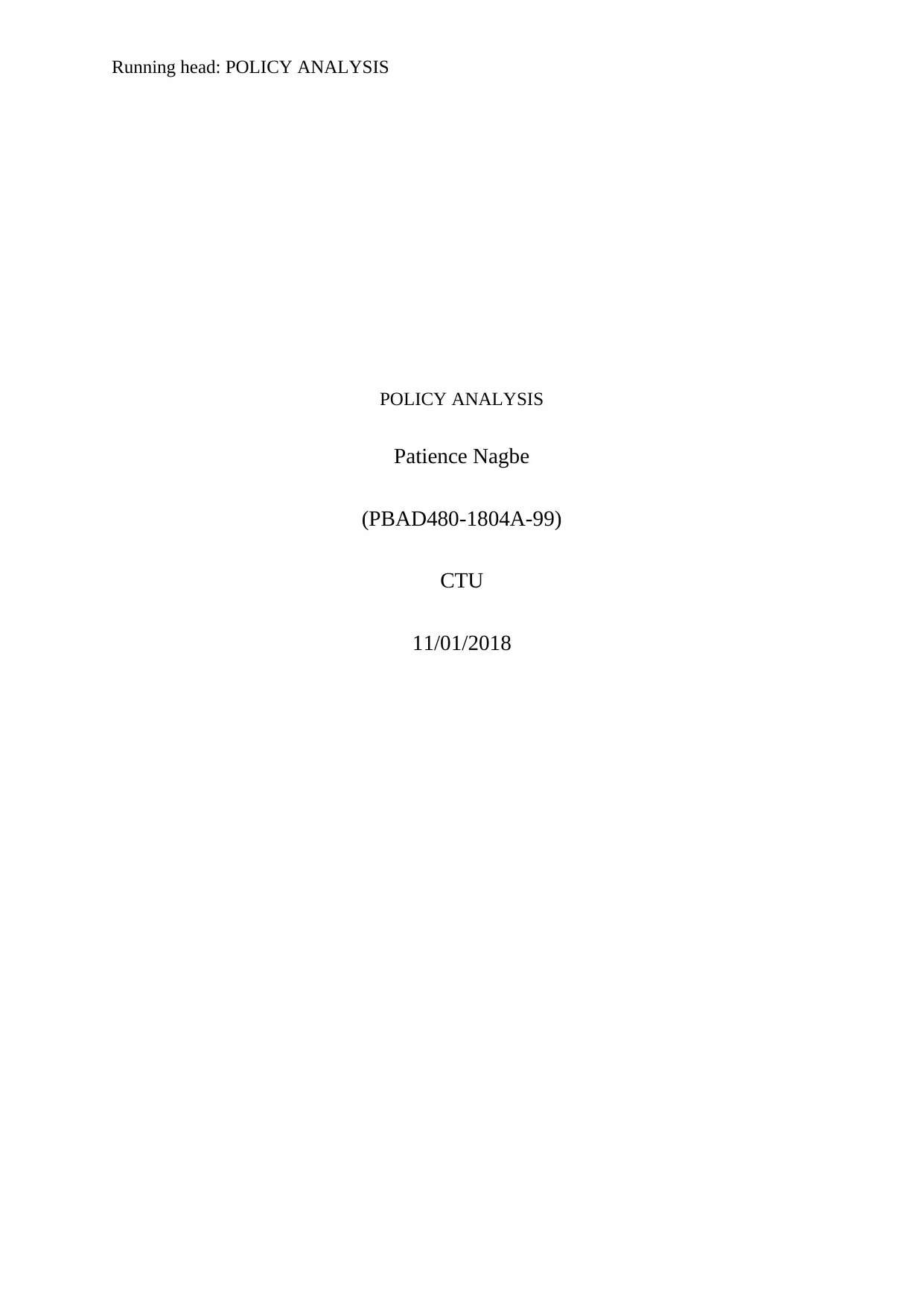
Running head: POLICY ANALYSIS
POLICY ANALYSIS
Patience Nagbe
(PBAD480-1804A-99)
CTU
11/01/2018
POLICY ANALYSIS
Patience Nagbe
(PBAD480-1804A-99)
CTU
11/01/2018
Paraphrase This Document
Need a fresh take? Get an instant paraphrase of this document with our AI Paraphraser
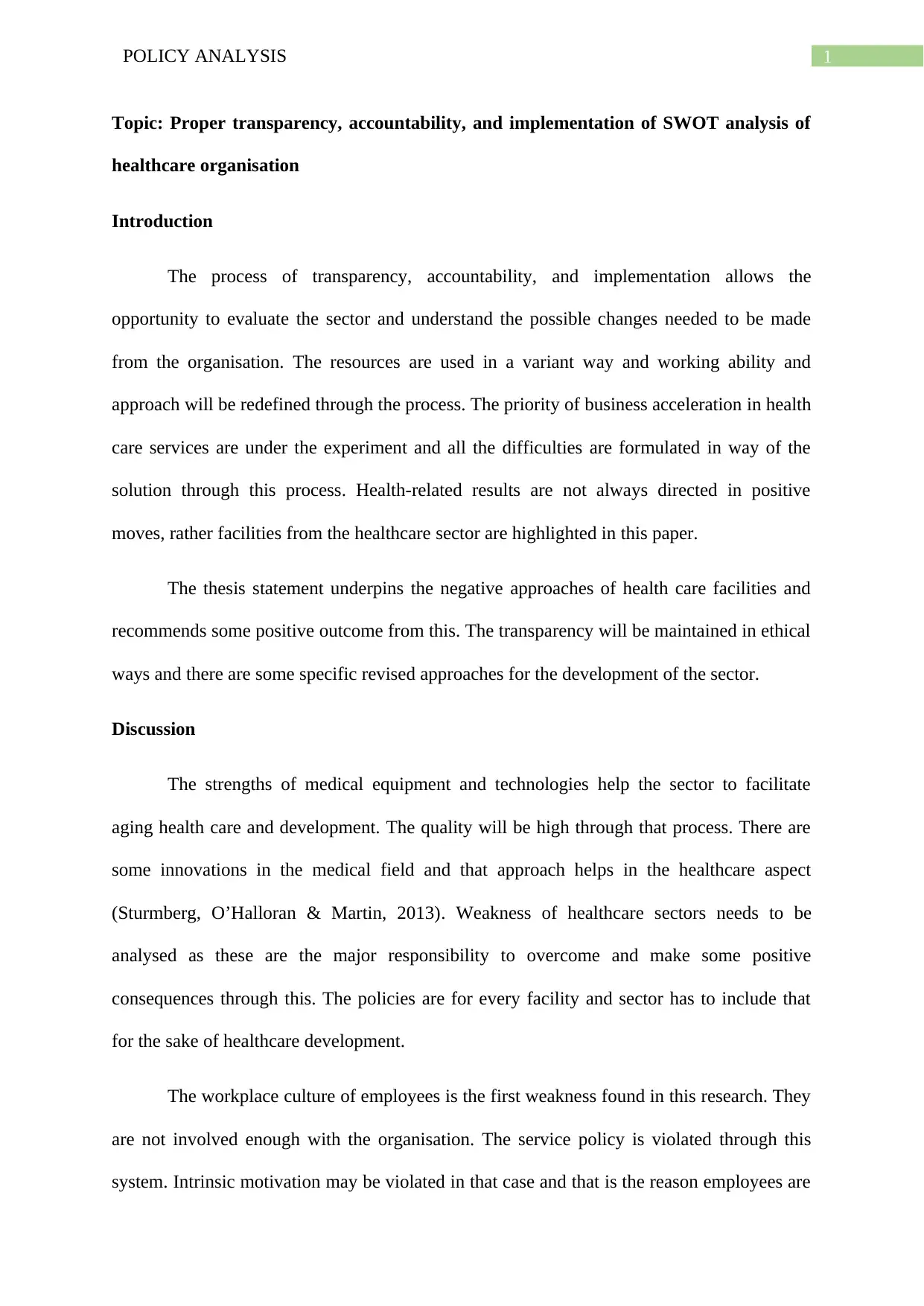
1POLICY ANALYSIS
Topic: Proper transparency, accountability, and implementation of SWOT analysis of
healthcare organisation
Introduction
The process of transparency, accountability, and implementation allows the
opportunity to evaluate the sector and understand the possible changes needed to be made
from the organisation. The resources are used in a variant way and working ability and
approach will be redefined through the process. The priority of business acceleration in health
care services are under the experiment and all the difficulties are formulated in way of the
solution through this process. Health-related results are not always directed in positive
moves, rather facilities from the healthcare sector are highlighted in this paper.
The thesis statement underpins the negative approaches of health care facilities and
recommends some positive outcome from this. The transparency will be maintained in ethical
ways and there are some specific revised approaches for the development of the sector.
Discussion
The strengths of medical equipment and technologies help the sector to facilitate
aging health care and development. The quality will be high through that process. There are
some innovations in the medical field and that approach helps in the healthcare aspect
(Sturmberg, O’Halloran & Martin, 2013). Weakness of healthcare sectors needs to be
analysed as these are the major responsibility to overcome and make some positive
consequences through this. The policies are for every facility and sector has to include that
for the sake of healthcare development.
The workplace culture of employees is the first weakness found in this research. They
are not involved enough with the organisation. The service policy is violated through this
system. Intrinsic motivation may be violated in that case and that is the reason employees are
Topic: Proper transparency, accountability, and implementation of SWOT analysis of
healthcare organisation
Introduction
The process of transparency, accountability, and implementation allows the
opportunity to evaluate the sector and understand the possible changes needed to be made
from the organisation. The resources are used in a variant way and working ability and
approach will be redefined through the process. The priority of business acceleration in health
care services are under the experiment and all the difficulties are formulated in way of the
solution through this process. Health-related results are not always directed in positive
moves, rather facilities from the healthcare sector are highlighted in this paper.
The thesis statement underpins the negative approaches of health care facilities and
recommends some positive outcome from this. The transparency will be maintained in ethical
ways and there are some specific revised approaches for the development of the sector.
Discussion
The strengths of medical equipment and technologies help the sector to facilitate
aging health care and development. The quality will be high through that process. There are
some innovations in the medical field and that approach helps in the healthcare aspect
(Sturmberg, O’Halloran & Martin, 2013). Weakness of healthcare sectors needs to be
analysed as these are the major responsibility to overcome and make some positive
consequences through this. The policies are for every facility and sector has to include that
for the sake of healthcare development.
The workplace culture of employees is the first weakness found in this research. They
are not involved enough with the organisation. The service policy is violated through this
system. Intrinsic motivation may be violated in that case and that is the reason employees are
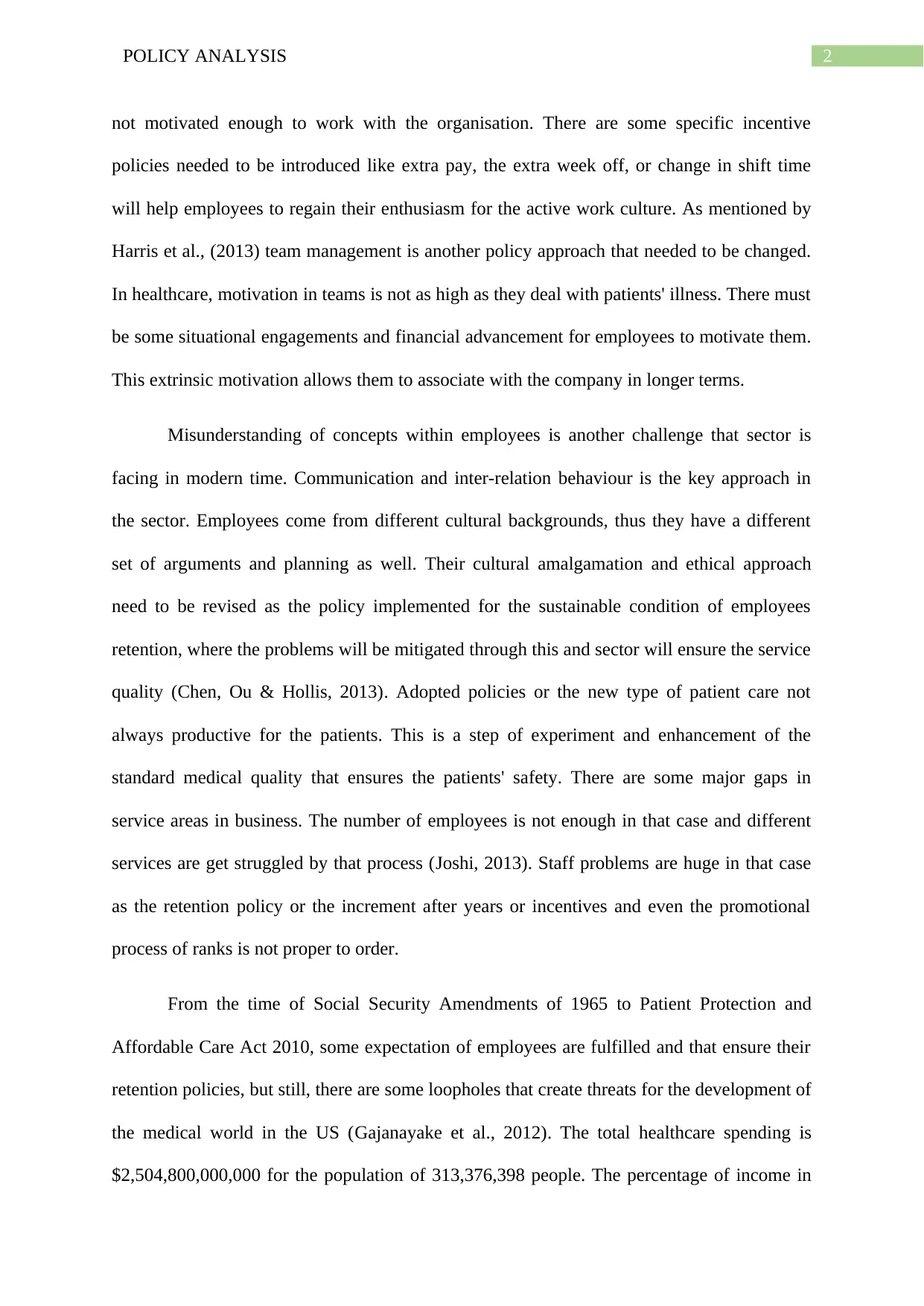
2POLICY ANALYSIS
not motivated enough to work with the organisation. There are some specific incentive
policies needed to be introduced like extra pay, the extra week off, or change in shift time
will help employees to regain their enthusiasm for the active work culture. As mentioned by
Harris et al., (2013) team management is another policy approach that needed to be changed.
In healthcare, motivation in teams is not as high as they deal with patients' illness. There must
be some situational engagements and financial advancement for employees to motivate them.
This extrinsic motivation allows them to associate with the company in longer terms.
Misunderstanding of concepts within employees is another challenge that sector is
facing in modern time. Communication and inter-relation behaviour is the key approach in
the sector. Employees come from different cultural backgrounds, thus they have a different
set of arguments and planning as well. Their cultural amalgamation and ethical approach
need to be revised as the policy implemented for the sustainable condition of employees
retention, where the problems will be mitigated through this and sector will ensure the service
quality (Chen, Ou & Hollis, 2013). Adopted policies or the new type of patient care not
always productive for the patients. This is a step of experiment and enhancement of the
standard medical quality that ensures the patients' safety. There are some major gaps in
service areas in business. The number of employees is not enough in that case and different
services are get struggled by that process (Joshi, 2013). Staff problems are huge in that case
as the retention policy or the increment after years or incentives and even the promotional
process of ranks is not proper to order.
From the time of Social Security Amendments of 1965 to Patient Protection and
Affordable Care Act 2010, some expectation of employees are fulfilled and that ensure their
retention policies, but still, there are some loopholes that create threats for the development of
the medical world in the US (Gajanayake et al., 2012). The total healthcare spending is
$2,504,800,000,000 for the population of 313,376,398 people. The percentage of income in
not motivated enough to work with the organisation. There are some specific incentive
policies needed to be introduced like extra pay, the extra week off, or change in shift time
will help employees to regain their enthusiasm for the active work culture. As mentioned by
Harris et al., (2013) team management is another policy approach that needed to be changed.
In healthcare, motivation in teams is not as high as they deal with patients' illness. There must
be some situational engagements and financial advancement for employees to motivate them.
This extrinsic motivation allows them to associate with the company in longer terms.
Misunderstanding of concepts within employees is another challenge that sector is
facing in modern time. Communication and inter-relation behaviour is the key approach in
the sector. Employees come from different cultural backgrounds, thus they have a different
set of arguments and planning as well. Their cultural amalgamation and ethical approach
need to be revised as the policy implemented for the sustainable condition of employees
retention, where the problems will be mitigated through this and sector will ensure the service
quality (Chen, Ou & Hollis, 2013). Adopted policies or the new type of patient care not
always productive for the patients. This is a step of experiment and enhancement of the
standard medical quality that ensures the patients' safety. There are some major gaps in
service areas in business. The number of employees is not enough in that case and different
services are get struggled by that process (Joshi, 2013). Staff problems are huge in that case
as the retention policy or the increment after years or incentives and even the promotional
process of ranks is not proper to order.
From the time of Social Security Amendments of 1965 to Patient Protection and
Affordable Care Act 2010, some expectation of employees are fulfilled and that ensure their
retention policies, but still, there are some loopholes that create threats for the development of
the medical world in the US (Gajanayake et al., 2012). The total healthcare spending is
$2,504,800,000,000 for the population of 313,376,398 people. The percentage of income in
⊘ This is a preview!⊘
Do you want full access?
Subscribe today to unlock all pages.

Trusted by 1+ million students worldwide
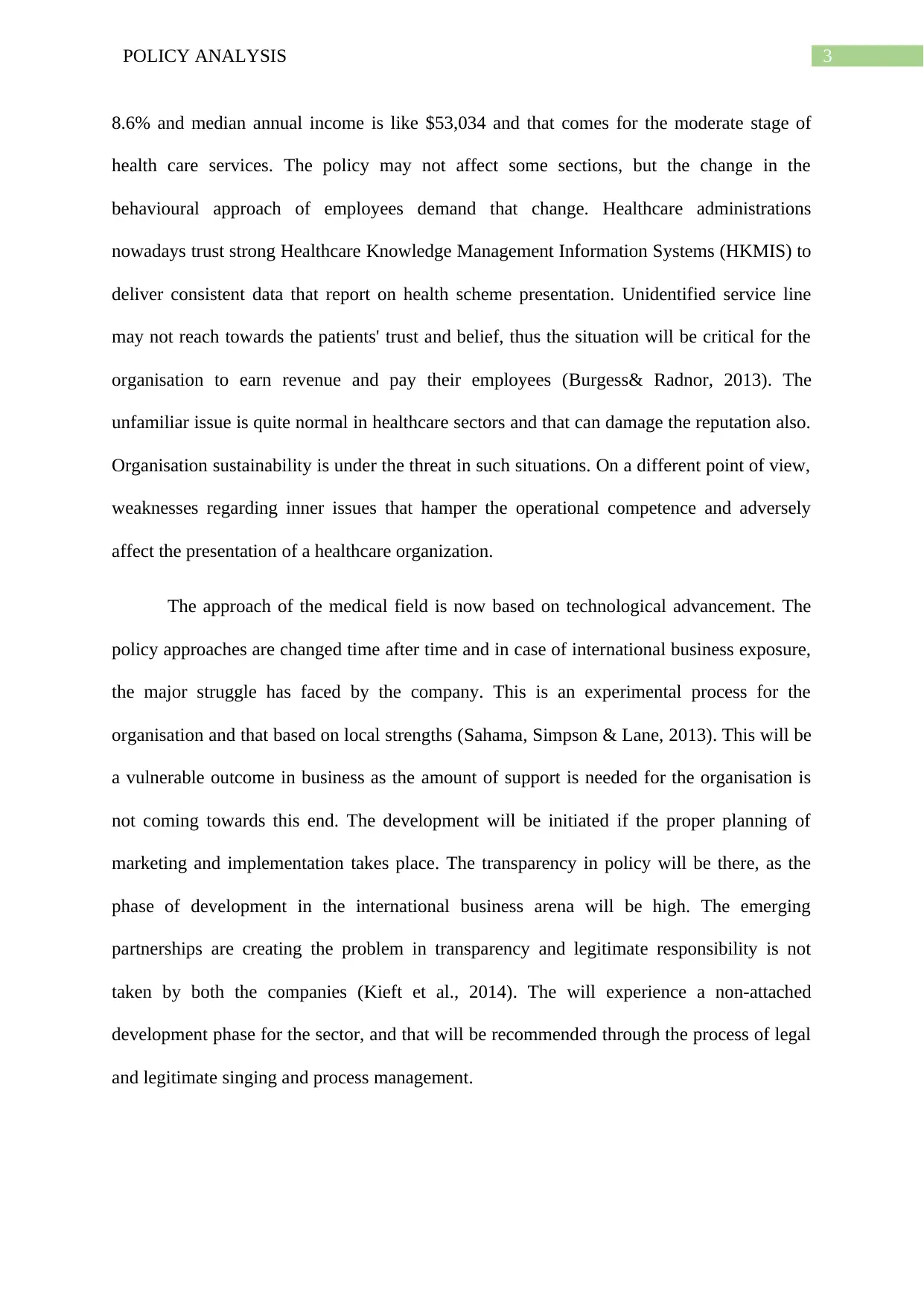
3POLICY ANALYSIS
8.6% and median annual income is like $53,034 and that comes for the moderate stage of
health care services. The policy may not affect some sections, but the change in the
behavioural approach of employees demand that change. Healthcare administrations
nowadays trust strong Healthcare Knowledge Management Information Systems (HKMIS) to
deliver consistent data that report on health scheme presentation. Unidentified service line
may not reach towards the patients' trust and belief, thus the situation will be critical for the
organisation to earn revenue and pay their employees (Burgess& Radnor, 2013). The
unfamiliar issue is quite normal in healthcare sectors and that can damage the reputation also.
Organisation sustainability is under the threat in such situations. On a different point of view,
weaknesses regarding inner issues that hamper the operational competence and adversely
affect the presentation of a healthcare organization.
The approach of the medical field is now based on technological advancement. The
policy approaches are changed time after time and in case of international business exposure,
the major struggle has faced by the company. This is an experimental process for the
organisation and that based on local strengths (Sahama, Simpson & Lane, 2013). This will be
a vulnerable outcome in business as the amount of support is needed for the organisation is
not coming towards this end. The development will be initiated if the proper planning of
marketing and implementation takes place. The transparency in policy will be there, as the
phase of development in the international business arena will be high. The emerging
partnerships are creating the problem in transparency and legitimate responsibility is not
taken by both the companies (Kieft et al., 2014). The will experience a non-attached
development phase for the sector, and that will be recommended through the process of legal
and legitimate singing and process management.
8.6% and median annual income is like $53,034 and that comes for the moderate stage of
health care services. The policy may not affect some sections, but the change in the
behavioural approach of employees demand that change. Healthcare administrations
nowadays trust strong Healthcare Knowledge Management Information Systems (HKMIS) to
deliver consistent data that report on health scheme presentation. Unidentified service line
may not reach towards the patients' trust and belief, thus the situation will be critical for the
organisation to earn revenue and pay their employees (Burgess& Radnor, 2013). The
unfamiliar issue is quite normal in healthcare sectors and that can damage the reputation also.
Organisation sustainability is under the threat in such situations. On a different point of view,
weaknesses regarding inner issues that hamper the operational competence and adversely
affect the presentation of a healthcare organization.
The approach of the medical field is now based on technological advancement. The
policy approaches are changed time after time and in case of international business exposure,
the major struggle has faced by the company. This is an experimental process for the
organisation and that based on local strengths (Sahama, Simpson & Lane, 2013). This will be
a vulnerable outcome in business as the amount of support is needed for the organisation is
not coming towards this end. The development will be initiated if the proper planning of
marketing and implementation takes place. The transparency in policy will be there, as the
phase of development in the international business arena will be high. The emerging
partnerships are creating the problem in transparency and legitimate responsibility is not
taken by both the companies (Kieft et al., 2014). The will experience a non-attached
development phase for the sector, and that will be recommended through the process of legal
and legitimate singing and process management.
Paraphrase This Document
Need a fresh take? Get an instant paraphrase of this document with our AI Paraphraser
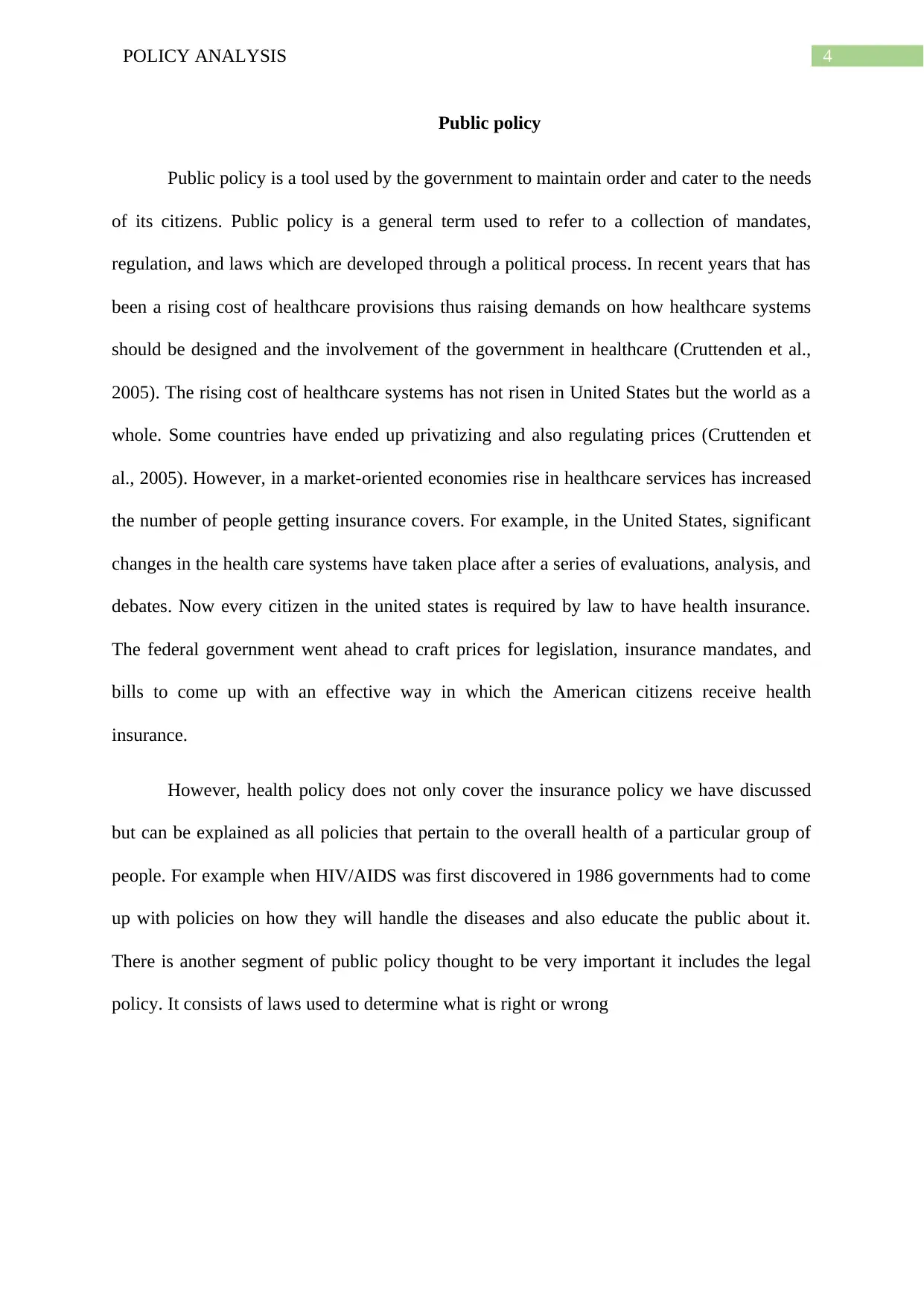
4POLICY ANALYSIS
Public policy
Public policy is a tool used by the government to maintain order and cater to the needs
of its citizens. Public policy is a general term used to refer to a collection of mandates,
regulation, and laws which are developed through a political process. In recent years that has
been a rising cost of healthcare provisions thus raising demands on how healthcare systems
should be designed and the involvement of the government in healthcare (Cruttenden et al.,
2005). The rising cost of healthcare systems has not risen in United States but the world as a
whole. Some countries have ended up privatizing and also regulating prices (Cruttenden et
al., 2005). However, in a market-oriented economies rise in healthcare services has increased
the number of people getting insurance covers. For example, in the United States, significant
changes in the health care systems have taken place after a series of evaluations, analysis, and
debates. Now every citizen in the united states is required by law to have health insurance.
The federal government went ahead to craft prices for legislation, insurance mandates, and
bills to come up with an effective way in which the American citizens receive health
insurance.
However, health policy does not only cover the insurance policy we have discussed
but can be explained as all policies that pertain to the overall health of a particular group of
people. For example when HIV/AIDS was first discovered in 1986 governments had to come
up with policies on how they will handle the diseases and also educate the public about it.
There is another segment of public policy thought to be very important it includes the legal
policy. It consists of laws used to determine what is right or wrong
Public policy
Public policy is a tool used by the government to maintain order and cater to the needs
of its citizens. Public policy is a general term used to refer to a collection of mandates,
regulation, and laws which are developed through a political process. In recent years that has
been a rising cost of healthcare provisions thus raising demands on how healthcare systems
should be designed and the involvement of the government in healthcare (Cruttenden et al.,
2005). The rising cost of healthcare systems has not risen in United States but the world as a
whole. Some countries have ended up privatizing and also regulating prices (Cruttenden et
al., 2005). However, in a market-oriented economies rise in healthcare services has increased
the number of people getting insurance covers. For example, in the United States, significant
changes in the health care systems have taken place after a series of evaluations, analysis, and
debates. Now every citizen in the united states is required by law to have health insurance.
The federal government went ahead to craft prices for legislation, insurance mandates, and
bills to come up with an effective way in which the American citizens receive health
insurance.
However, health policy does not only cover the insurance policy we have discussed
but can be explained as all policies that pertain to the overall health of a particular group of
people. For example when HIV/AIDS was first discovered in 1986 governments had to come
up with policies on how they will handle the diseases and also educate the public about it.
There is another segment of public policy thought to be very important it includes the legal
policy. It consists of laws used to determine what is right or wrong
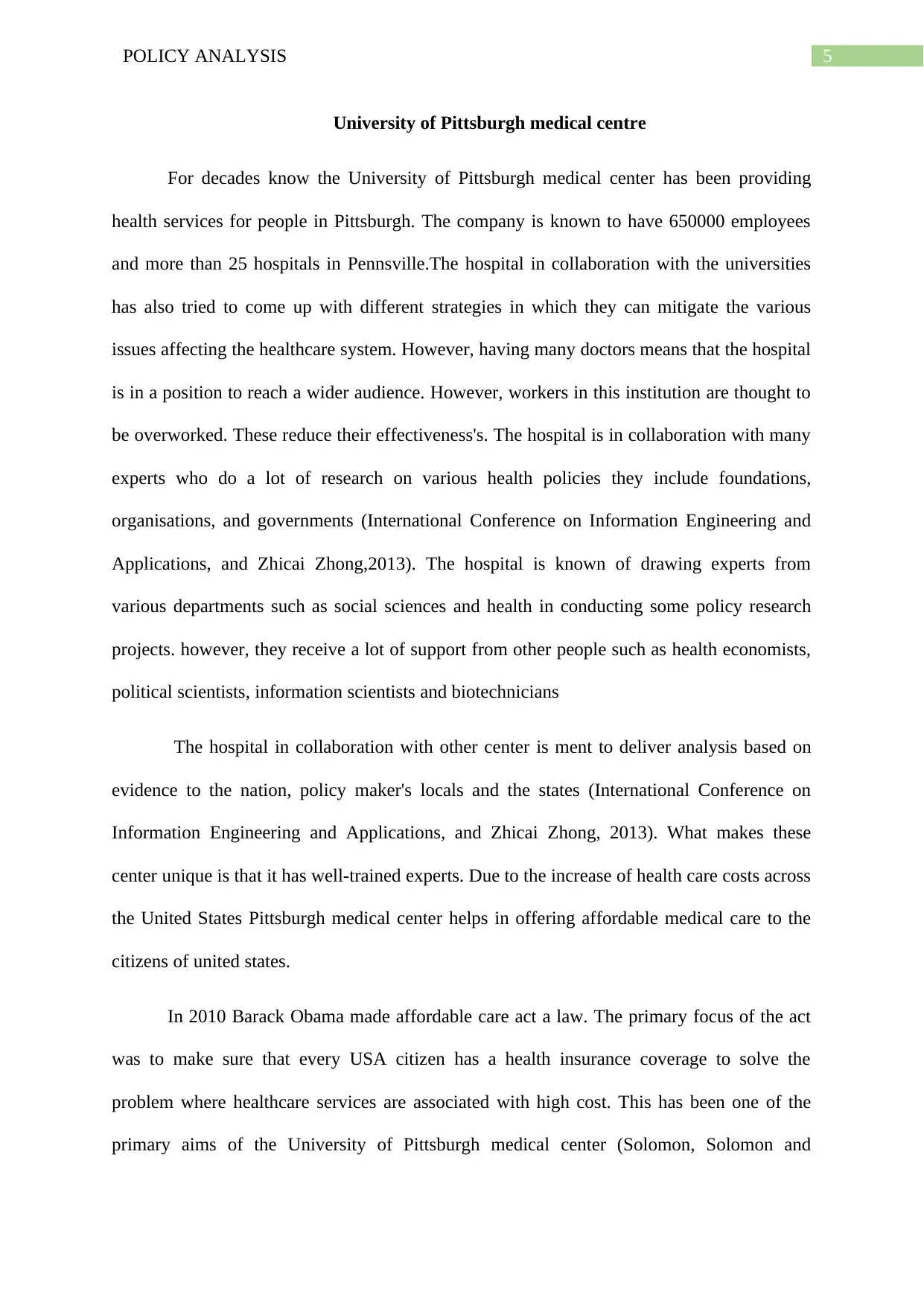
5POLICY ANALYSIS
University of Pittsburgh medical centre
For decades know the University of Pittsburgh medical center has been providing
health services for people in Pittsburgh. The company is known to have 650000 employees
and more than 25 hospitals in Pennsville.The hospital in collaboration with the universities
has also tried to come up with different strategies in which they can mitigate the various
issues affecting the healthcare system. However, having many doctors means that the hospital
is in a position to reach a wider audience. However, workers in this institution are thought to
be overworked. These reduce their effectiveness's. The hospital is in collaboration with many
experts who do a lot of research on various health policies they include foundations,
organisations, and governments (International Conference on Information Engineering and
Applications, and Zhicai Zhong,2013). The hospital is known of drawing experts from
various departments such as social sciences and health in conducting some policy research
projects. however, they receive a lot of support from other people such as health economists,
political scientists, information scientists and biotechnicians
The hospital in collaboration with other center is ment to deliver analysis based on
evidence to the nation, policy maker's locals and the states (International Conference on
Information Engineering and Applications, and Zhicai Zhong, 2013). What makes these
center unique is that it has well-trained experts. Due to the increase of health care costs across
the United States Pittsburgh medical center helps in offering affordable medical care to the
citizens of united states.
In 2010 Barack Obama made affordable care act a law. The primary focus of the act
was to make sure that every USA citizen has a health insurance coverage to solve the
problem where healthcare services are associated with high cost. This has been one of the
primary aims of the University of Pittsburgh medical center (Solomon, Solomon and
University of Pittsburgh medical centre
For decades know the University of Pittsburgh medical center has been providing
health services for people in Pittsburgh. The company is known to have 650000 employees
and more than 25 hospitals in Pennsville.The hospital in collaboration with the universities
has also tried to come up with different strategies in which they can mitigate the various
issues affecting the healthcare system. However, having many doctors means that the hospital
is in a position to reach a wider audience. However, workers in this institution are thought to
be overworked. These reduce their effectiveness's. The hospital is in collaboration with many
experts who do a lot of research on various health policies they include foundations,
organisations, and governments (International Conference on Information Engineering and
Applications, and Zhicai Zhong,2013). The hospital is known of drawing experts from
various departments such as social sciences and health in conducting some policy research
projects. however, they receive a lot of support from other people such as health economists,
political scientists, information scientists and biotechnicians
The hospital in collaboration with other center is ment to deliver analysis based on
evidence to the nation, policy maker's locals and the states (International Conference on
Information Engineering and Applications, and Zhicai Zhong, 2013). What makes these
center unique is that it has well-trained experts. Due to the increase of health care costs across
the United States Pittsburgh medical center helps in offering affordable medical care to the
citizens of united states.
In 2010 Barack Obama made affordable care act a law. The primary focus of the act
was to make sure that every USA citizen has a health insurance coverage to solve the
problem where healthcare services are associated with high cost. This has been one of the
primary aims of the University of Pittsburgh medical center (Solomon, Solomon and
⊘ This is a preview!⊘
Do you want full access?
Subscribe today to unlock all pages.

Trusted by 1+ million students worldwide
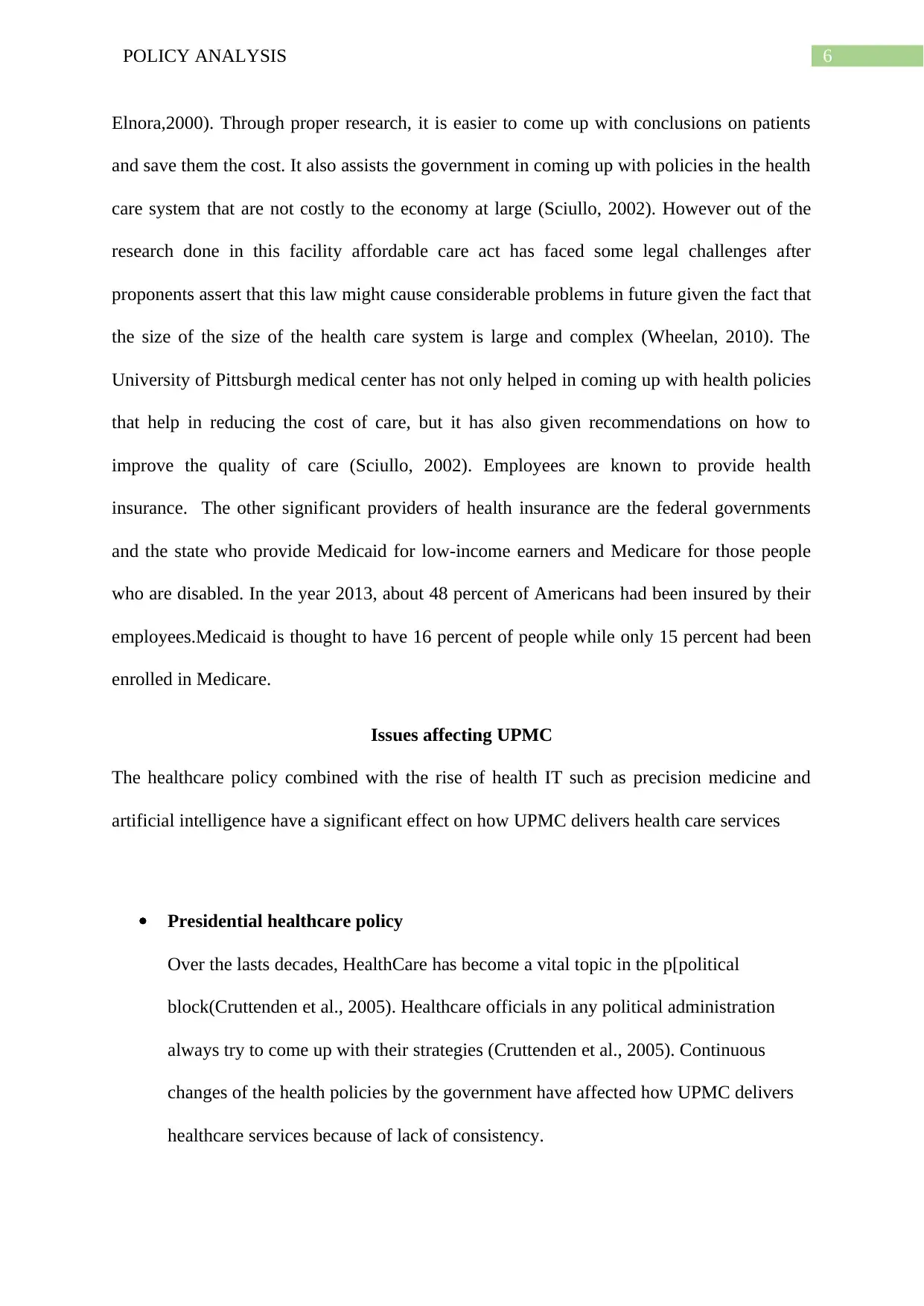
6POLICY ANALYSIS
Elnora,2000). Through proper research, it is easier to come up with conclusions on patients
and save them the cost. It also assists the government in coming up with policies in the health
care system that are not costly to the economy at large (Sciullo, 2002). However out of the
research done in this facility affordable care act has faced some legal challenges after
proponents assert that this law might cause considerable problems in future given the fact that
the size of the size of the health care system is large and complex (Wheelan, 2010). The
University of Pittsburgh medical center has not only helped in coming up with health policies
that help in reducing the cost of care, but it has also given recommendations on how to
improve the quality of care (Sciullo, 2002). Employees are known to provide health
insurance. The other significant providers of health insurance are the federal governments
and the state who provide Medicaid for low-income earners and Medicare for those people
who are disabled. In the year 2013, about 48 percent of Americans had been insured by their
employees.Medicaid is thought to have 16 percent of people while only 15 percent had been
enrolled in Medicare.
Issues affecting UPMC
The healthcare policy combined with the rise of health IT such as precision medicine and
artificial intelligence have a significant effect on how UPMC delivers health care services
Presidential healthcare policy
Over the lasts decades, HealthCare has become a vital topic in the p[political
block(Cruttenden et al., 2005). Healthcare officials in any political administration
always try to come up with their strategies (Cruttenden et al., 2005). Continuous
changes of the health policies by the government have affected how UPMC delivers
healthcare services because of lack of consistency.
Elnora,2000). Through proper research, it is easier to come up with conclusions on patients
and save them the cost. It also assists the government in coming up with policies in the health
care system that are not costly to the economy at large (Sciullo, 2002). However out of the
research done in this facility affordable care act has faced some legal challenges after
proponents assert that this law might cause considerable problems in future given the fact that
the size of the size of the health care system is large and complex (Wheelan, 2010). The
University of Pittsburgh medical center has not only helped in coming up with health policies
that help in reducing the cost of care, but it has also given recommendations on how to
improve the quality of care (Sciullo, 2002). Employees are known to provide health
insurance. The other significant providers of health insurance are the federal governments
and the state who provide Medicaid for low-income earners and Medicare for those people
who are disabled. In the year 2013, about 48 percent of Americans had been insured by their
employees.Medicaid is thought to have 16 percent of people while only 15 percent had been
enrolled in Medicare.
Issues affecting UPMC
The healthcare policy combined with the rise of health IT such as precision medicine and
artificial intelligence have a significant effect on how UPMC delivers health care services
Presidential healthcare policy
Over the lasts decades, HealthCare has become a vital topic in the p[political
block(Cruttenden et al., 2005). Healthcare officials in any political administration
always try to come up with their strategies (Cruttenden et al., 2005). Continuous
changes of the health policies by the government have affected how UPMC delivers
healthcare services because of lack of consistency.
Paraphrase This Document
Need a fresh take? Get an instant paraphrase of this document with our AI Paraphraser
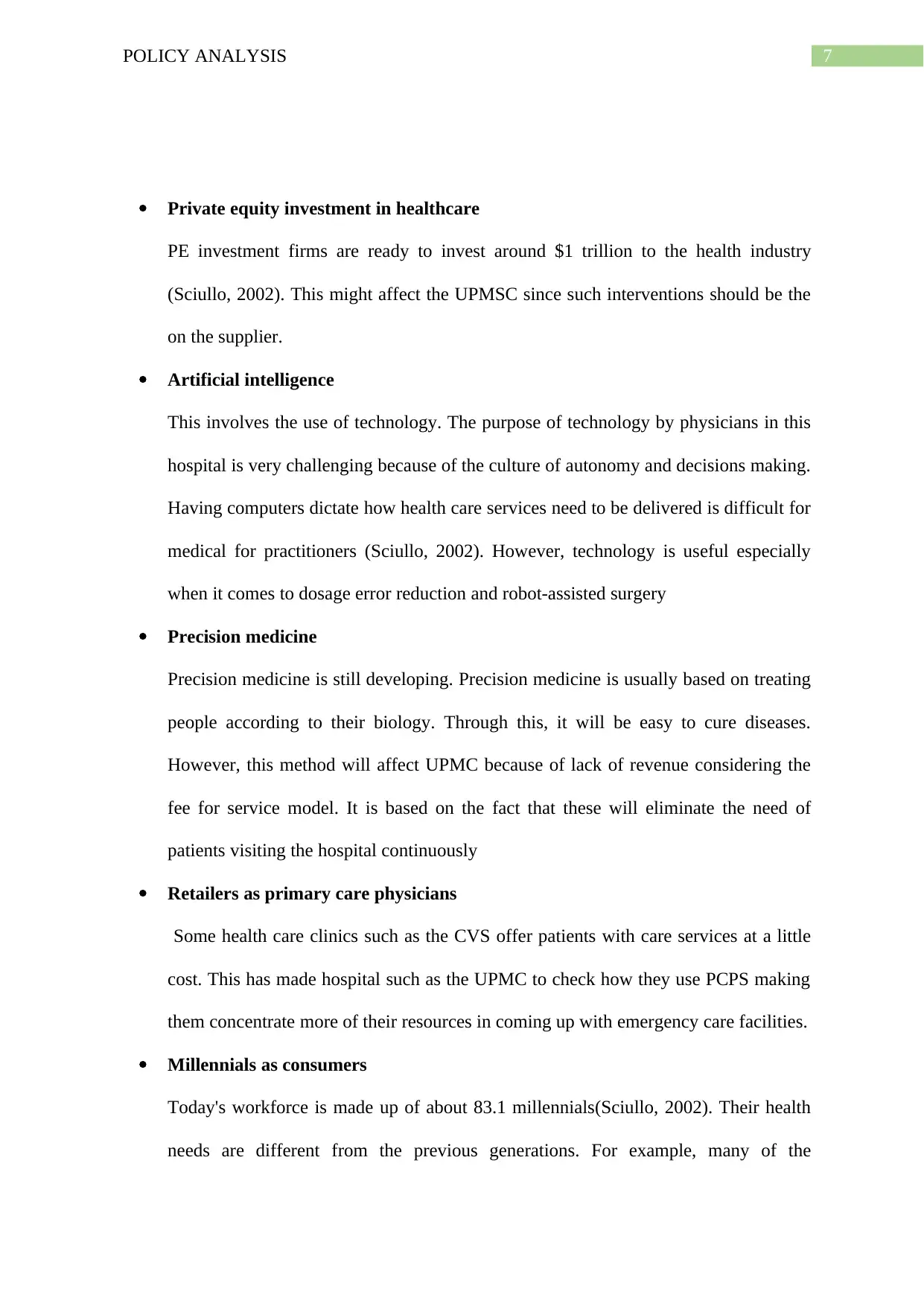
7POLICY ANALYSIS
Private equity investment in healthcare
PE investment firms are ready to invest around $1 trillion to the health industry
(Sciullo, 2002). This might affect the UPMSC since such interventions should be the
on the supplier.
Artificial intelligence
This involves the use of technology. The purpose of technology by physicians in this
hospital is very challenging because of the culture of autonomy and decisions making.
Having computers dictate how health care services need to be delivered is difficult for
medical for practitioners (Sciullo, 2002). However, technology is useful especially
when it comes to dosage error reduction and robot-assisted surgery
Precision medicine
Precision medicine is still developing. Precision medicine is usually based on treating
people according to their biology. Through this, it will be easy to cure diseases.
However, this method will affect UPMC because of lack of revenue considering the
fee for service model. It is based on the fact that these will eliminate the need of
patients visiting the hospital continuously
Retailers as primary care physicians
Some health care clinics such as the CVS offer patients with care services at a little
cost. This has made hospital such as the UPMC to check how they use PCPS making
them concentrate more of their resources in coming up with emergency care facilities.
Millennials as consumers
Today's workforce is made up of about 83.1 millennials(Sciullo, 2002). Their health
needs are different from the previous generations. For example, many of the
Private equity investment in healthcare
PE investment firms are ready to invest around $1 trillion to the health industry
(Sciullo, 2002). This might affect the UPMSC since such interventions should be the
on the supplier.
Artificial intelligence
This involves the use of technology. The purpose of technology by physicians in this
hospital is very challenging because of the culture of autonomy and decisions making.
Having computers dictate how health care services need to be delivered is difficult for
medical for practitioners (Sciullo, 2002). However, technology is useful especially
when it comes to dosage error reduction and robot-assisted surgery
Precision medicine
Precision medicine is still developing. Precision medicine is usually based on treating
people according to their biology. Through this, it will be easy to cure diseases.
However, this method will affect UPMC because of lack of revenue considering the
fee for service model. It is based on the fact that these will eliminate the need of
patients visiting the hospital continuously
Retailers as primary care physicians
Some health care clinics such as the CVS offer patients with care services at a little
cost. This has made hospital such as the UPMC to check how they use PCPS making
them concentrate more of their resources in coming up with emergency care facilities.
Millennials as consumers
Today's workforce is made up of about 83.1 millennials(Sciullo, 2002). Their health
needs are different from the previous generations. For example, many of the
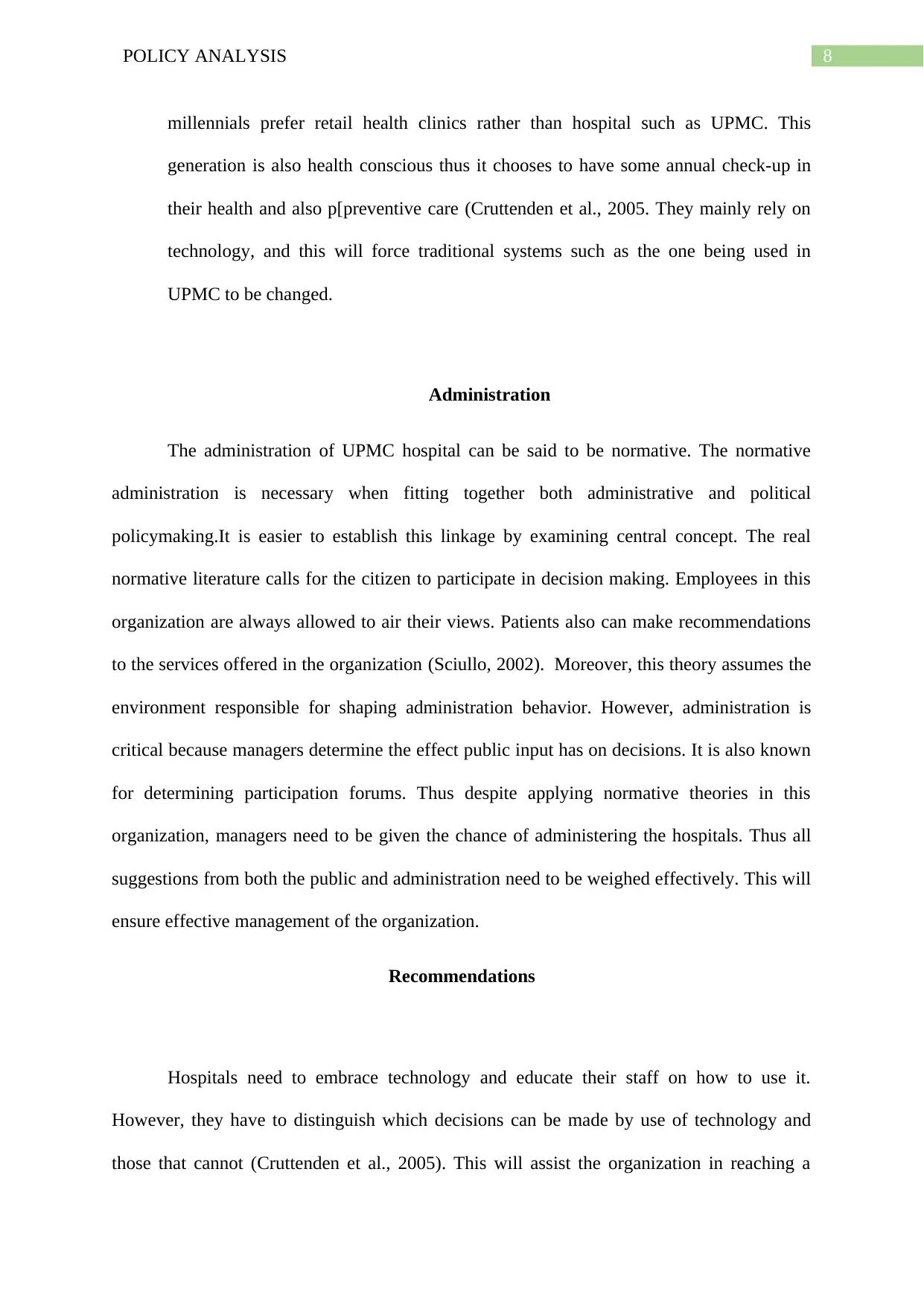
8POLICY ANALYSIS
millennials prefer retail health clinics rather than hospital such as UPMC. This
generation is also health conscious thus it chooses to have some annual check-up in
their health and also p[preventive care (Cruttenden et al., 2005. They mainly rely on
technology, and this will force traditional systems such as the one being used in
UPMC to be changed.
Administration
The administration of UPMC hospital can be said to be normative. The normative
administration is necessary when fitting together both administrative and political
policymaking.It is easier to establish this linkage by examining central concept. The real
normative literature calls for the citizen to participate in decision making. Employees in this
organization are always allowed to air their views. Patients also can make recommendations
to the services offered in the organization (Sciullo, 2002). Moreover, this theory assumes the
environment responsible for shaping administration behavior. However, administration is
critical because managers determine the effect public input has on decisions. It is also known
for determining participation forums. Thus despite applying normative theories in this
organization, managers need to be given the chance of administering the hospitals. Thus all
suggestions from both the public and administration need to be weighed effectively. This will
ensure effective management of the organization.
Recommendations
Hospitals need to embrace technology and educate their staff on how to use it.
However, they have to distinguish which decisions can be made by use of technology and
those that cannot (Cruttenden et al., 2005). This will assist the organization in reaching a
millennials prefer retail health clinics rather than hospital such as UPMC. This
generation is also health conscious thus it chooses to have some annual check-up in
their health and also p[preventive care (Cruttenden et al., 2005. They mainly rely on
technology, and this will force traditional systems such as the one being used in
UPMC to be changed.
Administration
The administration of UPMC hospital can be said to be normative. The normative
administration is necessary when fitting together both administrative and political
policymaking.It is easier to establish this linkage by examining central concept. The real
normative literature calls for the citizen to participate in decision making. Employees in this
organization are always allowed to air their views. Patients also can make recommendations
to the services offered in the organization (Sciullo, 2002). Moreover, this theory assumes the
environment responsible for shaping administration behavior. However, administration is
critical because managers determine the effect public input has on decisions. It is also known
for determining participation forums. Thus despite applying normative theories in this
organization, managers need to be given the chance of administering the hospitals. Thus all
suggestions from both the public and administration need to be weighed effectively. This will
ensure effective management of the organization.
Recommendations
Hospitals need to embrace technology and educate their staff on how to use it.
However, they have to distinguish which decisions can be made by use of technology and
those that cannot (Cruttenden et al., 2005). This will assist the organization in reaching a
⊘ This is a preview!⊘
Do you want full access?
Subscribe today to unlock all pages.

Trusted by 1+ million students worldwide
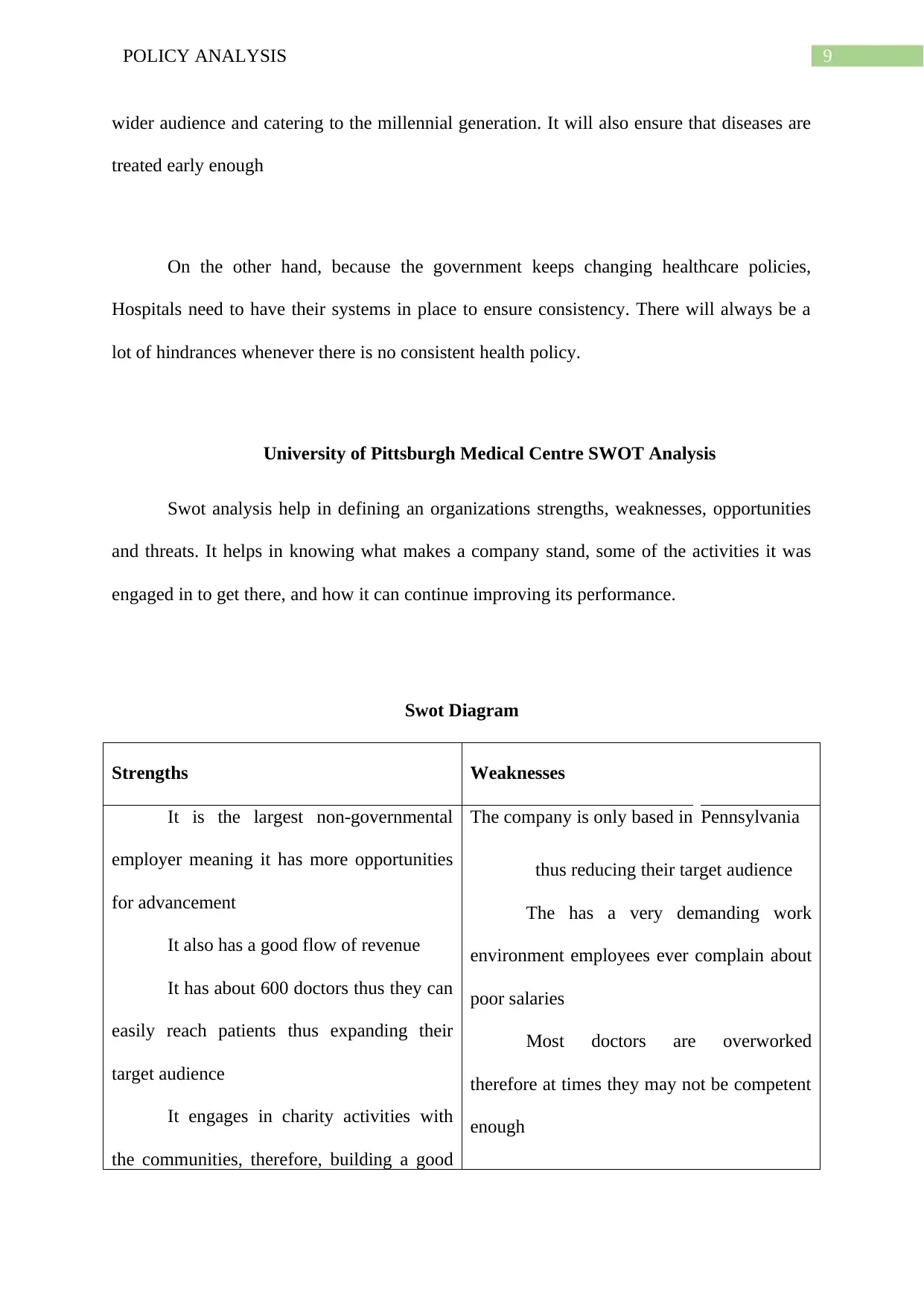
9POLICY ANALYSIS
wider audience and catering to the millennial generation. It will also ensure that diseases are
treated early enough
On the other hand, because the government keeps changing healthcare policies,
Hospitals need to have their systems in place to ensure consistency. There will always be a
lot of hindrances whenever there is no consistent health policy.
University of Pittsburgh Medical Centre SWOT Analysis
Swot analysis help in defining an organizations strengths, weaknesses, opportunities
and threats. It helps in knowing what makes a company stand, some of the activities it was
engaged in to get there, and how it can continue improving its performance.
Swot Diagram
Strengths Weaknesses
It is the largest non-governmental
employer meaning it has more opportunities
for advancement
It also has a good flow of revenue
It has about 600 doctors thus they can
easily reach patients thus expanding their
target audience
It engages in charity activities with
the communities, therefore, building a good
The company is only based in Pennsylvania
thus reducing their target audience
The has a very demanding work
environment employees ever complain about
poor salaries
Most doctors are overworked
therefore at times they may not be competent
enough
wider audience and catering to the millennial generation. It will also ensure that diseases are
treated early enough
On the other hand, because the government keeps changing healthcare policies,
Hospitals need to have their systems in place to ensure consistency. There will always be a
lot of hindrances whenever there is no consistent health policy.
University of Pittsburgh Medical Centre SWOT Analysis
Swot analysis help in defining an organizations strengths, weaknesses, opportunities
and threats. It helps in knowing what makes a company stand, some of the activities it was
engaged in to get there, and how it can continue improving its performance.
Swot Diagram
Strengths Weaknesses
It is the largest non-governmental
employer meaning it has more opportunities
for advancement
It also has a good flow of revenue
It has about 600 doctors thus they can
easily reach patients thus expanding their
target audience
It engages in charity activities with
the communities, therefore, building a good
The company is only based in Pennsylvania
thus reducing their target audience
The has a very demanding work
environment employees ever complain about
poor salaries
Most doctors are overworked
therefore at times they may not be competent
enough
Paraphrase This Document
Need a fresh take? Get an instant paraphrase of this document with our AI Paraphraser
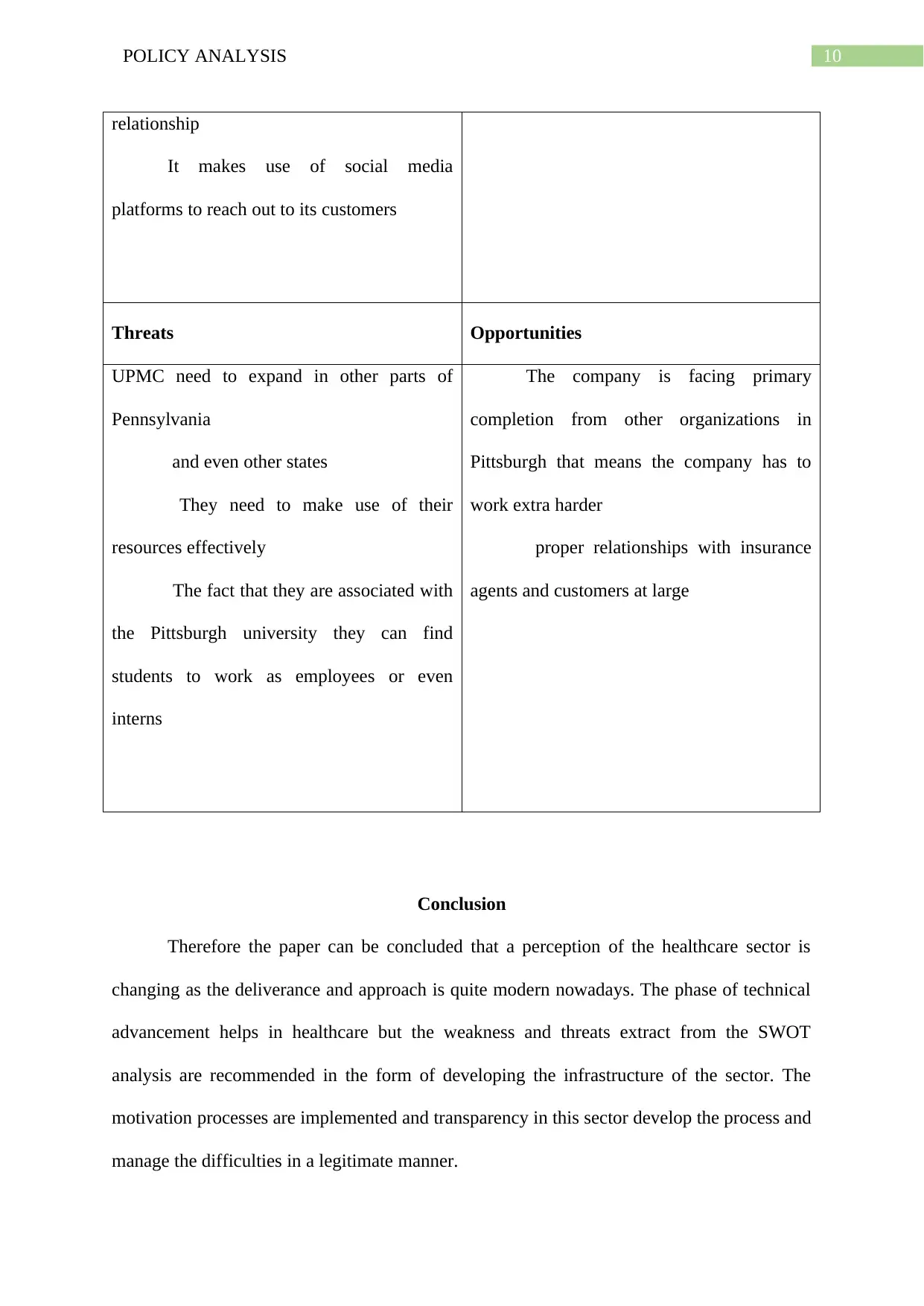
10POLICY ANALYSIS
relationship
It makes use of social media
platforms to reach out to its customers
Threats Opportunities
UPMC need to expand in other parts of
Pennsylvania
and even other states
They need to make use of their
resources effectively
The fact that they are associated with
the Pittsburgh university they can find
students to work as employees or even
interns
The company is facing primary
completion from other organizations in
Pittsburgh that means the company has to
work extra harder
proper relationships with insurance
agents and customers at large
Conclusion
Therefore the paper can be concluded that a perception of the healthcare sector is
changing as the deliverance and approach is quite modern nowadays. The phase of technical
advancement helps in healthcare but the weakness and threats extract from the SWOT
analysis are recommended in the form of developing the infrastructure of the sector. The
motivation processes are implemented and transparency in this sector develop the process and
manage the difficulties in a legitimate manner.
relationship
It makes use of social media
platforms to reach out to its customers
Threats Opportunities
UPMC need to expand in other parts of
Pennsylvania
and even other states
They need to make use of their
resources effectively
The fact that they are associated with
the Pittsburgh university they can find
students to work as employees or even
interns
The company is facing primary
completion from other organizations in
Pittsburgh that means the company has to
work extra harder
proper relationships with insurance
agents and customers at large
Conclusion
Therefore the paper can be concluded that a perception of the healthcare sector is
changing as the deliverance and approach is quite modern nowadays. The phase of technical
advancement helps in healthcare but the weakness and threats extract from the SWOT
analysis are recommended in the form of developing the infrastructure of the sector. The
motivation processes are implemented and transparency in this sector develop the process and
manage the difficulties in a legitimate manner.
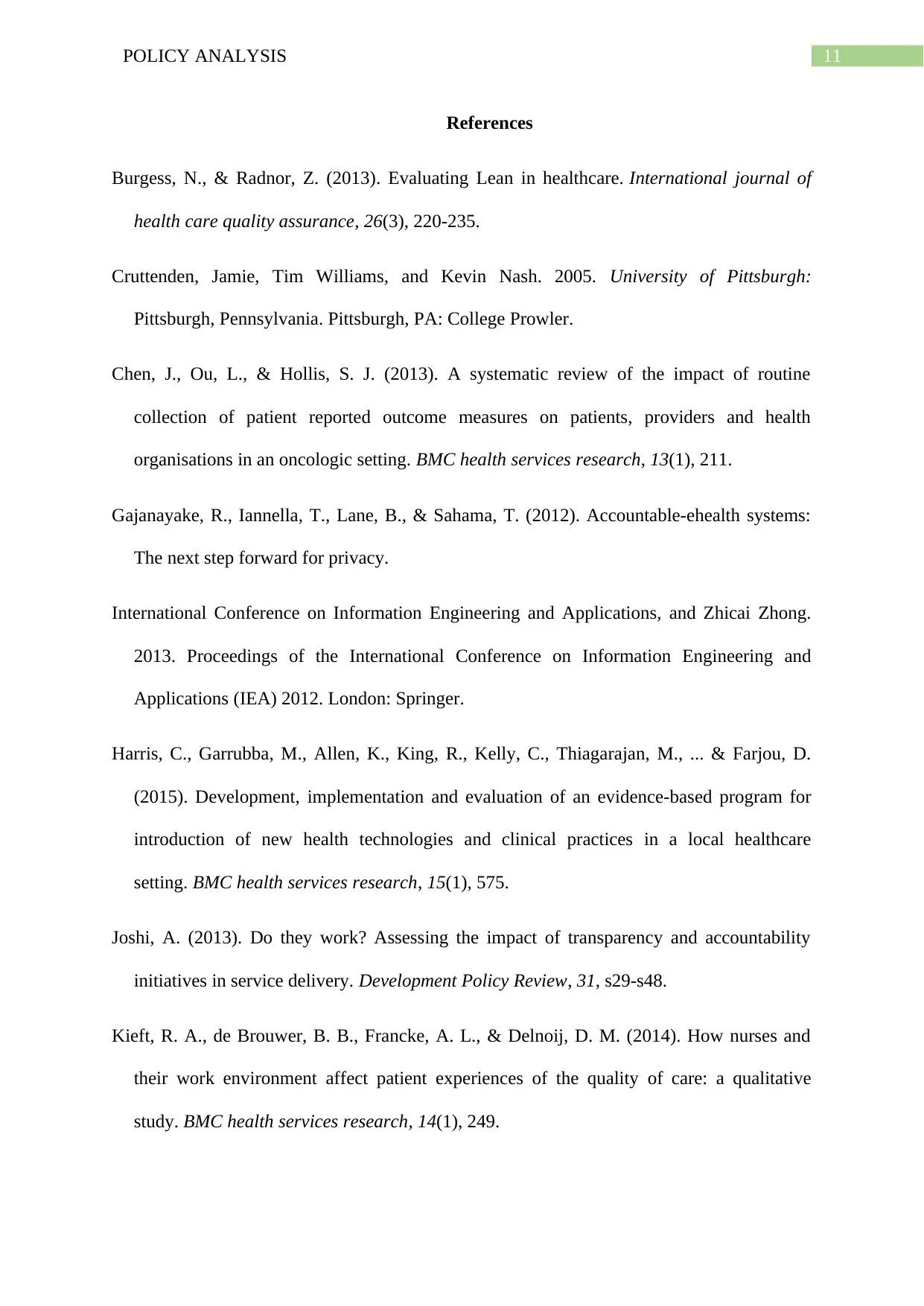
11POLICY ANALYSIS
References
Burgess, N., & Radnor, Z. (2013). Evaluating Lean in healthcare. International journal of
health care quality assurance, 26(3), 220-235.
Cruttenden, Jamie, Tim Williams, and Kevin Nash. 2005. University of Pittsburgh:
Pittsburgh, Pennsylvania. Pittsburgh, PA: College Prowler.
Chen, J., Ou, L., & Hollis, S. J. (2013). A systematic review of the impact of routine
collection of patient reported outcome measures on patients, providers and health
organisations in an oncologic setting. BMC health services research, 13(1), 211.
Gajanayake, R., Iannella, T., Lane, B., & Sahama, T. (2012). Accountable-ehealth systems:
The next step forward for privacy.
International Conference on Information Engineering and Applications, and Zhicai Zhong.
2013. Proceedings of the International Conference on Information Engineering and
Applications (IEA) 2012. London: Springer.
Harris, C., Garrubba, M., Allen, K., King, R., Kelly, C., Thiagarajan, M., ... & Farjou, D.
(2015). Development, implementation and evaluation of an evidence-based program for
introduction of new health technologies and clinical practices in a local healthcare
setting. BMC health services research, 15(1), 575.
Joshi, A. (2013). Do they work? Assessing the impact of transparency and accountability
initiatives in service delivery. Development Policy Review, 31, s29-s48.
Kieft, R. A., de Brouwer, B. B., Francke, A. L., & Delnoij, D. M. (2014). How nurses and
their work environment affect patient experiences of the quality of care: a qualitative
study. BMC health services research, 14(1), 249.
References
Burgess, N., & Radnor, Z. (2013). Evaluating Lean in healthcare. International journal of
health care quality assurance, 26(3), 220-235.
Cruttenden, Jamie, Tim Williams, and Kevin Nash. 2005. University of Pittsburgh:
Pittsburgh, Pennsylvania. Pittsburgh, PA: College Prowler.
Chen, J., Ou, L., & Hollis, S. J. (2013). A systematic review of the impact of routine
collection of patient reported outcome measures on patients, providers and health
organisations in an oncologic setting. BMC health services research, 13(1), 211.
Gajanayake, R., Iannella, T., Lane, B., & Sahama, T. (2012). Accountable-ehealth systems:
The next step forward for privacy.
International Conference on Information Engineering and Applications, and Zhicai Zhong.
2013. Proceedings of the International Conference on Information Engineering and
Applications (IEA) 2012. London: Springer.
Harris, C., Garrubba, M., Allen, K., King, R., Kelly, C., Thiagarajan, M., ... & Farjou, D.
(2015). Development, implementation and evaluation of an evidence-based program for
introduction of new health technologies and clinical practices in a local healthcare
setting. BMC health services research, 15(1), 575.
Joshi, A. (2013). Do they work? Assessing the impact of transparency and accountability
initiatives in service delivery. Development Policy Review, 31, s29-s48.
Kieft, R. A., de Brouwer, B. B., Francke, A. L., & Delnoij, D. M. (2014). How nurses and
their work environment affect patient experiences of the quality of care: a qualitative
study. BMC health services research, 14(1), 249.
⊘ This is a preview!⊘
Do you want full access?
Subscribe today to unlock all pages.

Trusted by 1+ million students worldwide
1 out of 13
Related Documents
Your All-in-One AI-Powered Toolkit for Academic Success.
+13062052269
info@desklib.com
Available 24*7 on WhatsApp / Email
![[object Object]](/_next/static/media/star-bottom.7253800d.svg)
Unlock your academic potential
Copyright © 2020–2025 A2Z Services. All Rights Reserved. Developed and managed by ZUCOL.





